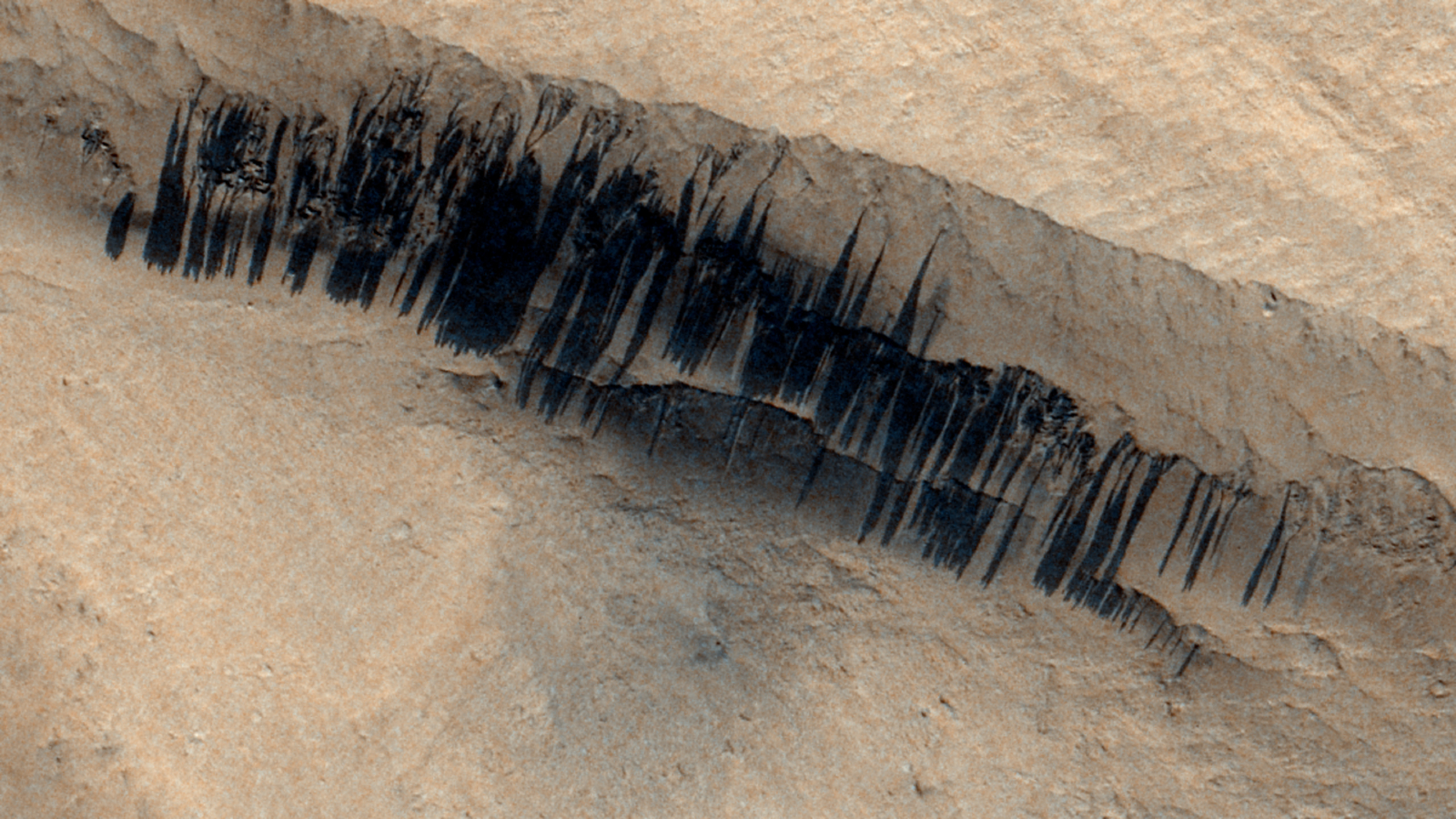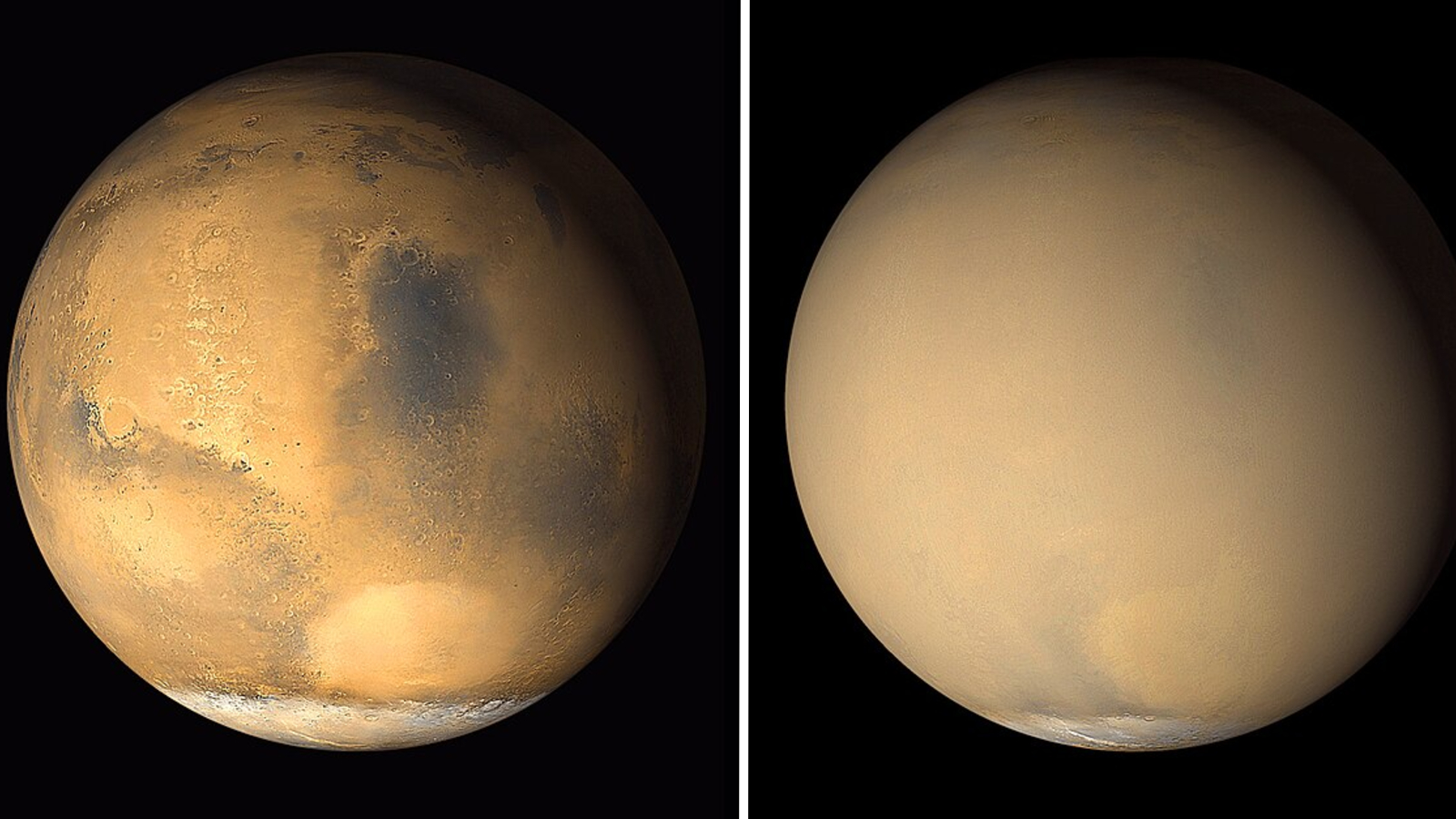2 million black 'streaks' on Mars finally have an explanation, solving 50-year mystery
A new analysis of data from NASA's Mars Reconnaissance Orbiter reveals that the majority of the Red Planet's dark "slope streaks" did not form as most researchers previously assumed.

Millions of mysterious black streaks littered across the surface of Mars have puzzled scientists for decades, but now researchers may finally have a proper explanation. The new theory also explains why it has taken so long to solve this particular problem.
Martian "slope streaks" are dark albedo features that cover the slopes of topographical features across the Red Planet. They were discovered in the 1970s, and scientists initially assumed they were evidence of landslides caused by melting ice. But while scientists still think that the streaks are the result of landslides, a study published in May revealed that these landslides are actually triggered by "dry processes" that do not involve any water. This narrowed down the list of potential causes but did not conclusively settle the debate around the streaks' origins.
One of the most famous examples of these streaks is on Apollinaris Mons — an extinct shield volcano located just south of Mars' equator. Here, hundreds of parallel streaks can be seen on a single side of a large ridge, giving the structure a "barcode-like" appearance (see below). These streaks appeared at some point between 2013 and 2017, and scientists later realized that they were the result of a nearby meteoroid impact, Live Science's sister site Space.com reported.
As a result, some researchers assumed that meteoroid impacts and other seismic events, such as marsquakes, are responsible for birthing most slope streaks. But a new study, published Nov. 6 in the journal Nature Communications, suggests that this is not the case.
Instead, an analysis of around 2.1 million slope streaks, photographed by NASA's Mars Reconnaissance Orbiter between 2006 and 2024, revealed that almost all new streaks are the result of seasonal wind and dust erosion. (The study estimates the total number of slope streaks on Mars to be around 1.6 million, but some streaks were included in multiple image sets.)

"Dust, wind and sand dynamics appear to be the main seasonal drivers of slope streak formation," the study's sole author Valentin Bickel, a planetary scientist at the University of Bern in Switzerland who also co-authored the May study, said in a statement. "Meteoroid impacts and quakes seem to be locally distinct, yet globally relatively insignificant drivers [of streak formation]," he added.
Bickel estimates that less than 0.1% of newly formed slope streaks are created by meteoroid impacts or marsquakes.
Get the world’s most fascinating discoveries delivered straight to your inbox.
Bickel's analysis showed that slope streaks are grouped into five key regions across Mars, and that new streaks form in each of these areas when seasonal wind speeds are highest and exceed the threshold for "dust mobilization." Once this threshold has been surpassed, landslides can more easily occur in that area, Bickel added.
This process is similar to how high winds can pick up Martian dust and trigger sizable tornadoes, or "dust devils," on the Red Planet's wide-open plains.
The reason it has taken scientists so long to solve this puzzle is likely because it all happens under the cover of darkness. "The conditions most conducive to seasonal streak formation appear to occur at sunrise and sunset, explaining the lack of direct observations of streak-forming events to date," Bickel wrote in the study.

The study also revealed that slope streak formation likely occurs at an annual rate of around 0.05 new streaks per existing streak. Given that there are estimated to be 1.6 million slope streaks, that means the current rate of formation is around 80,000 new streaks per year. Most streaks likely last for several decades before disappearing, but there is not enough orbiter data to tell for sure.
While slope streaks cover less than 0.1% of Mars' surface, the new study suggests that they may be the largest single contributor to atmospheric dust. Therefore, better understanding the streaks' role in the Martian dust cycle, which could impact future human colonies on Mars, should be a key goal for future Mars missions.
"These observations could lead to a better understanding of what happens on Mars today," Colin Wilson, the European Space Agency's project scientist for the ExoMars Trace Gas Orbiter, who was not involved in the new study, said in the statement. "Obtaining long-term, continuous and global-scale observations that reveal a dynamic Mars is a key objective of present and future orbiters."

Harry is a U.K.-based senior staff writer at Live Science. He studied marine biology at the University of Exeter before training to become a journalist. He covers a wide range of topics including space exploration, planetary science, space weather, climate change, animal behavior and paleontology. His recent work on the solar maximum won "best space submission" at the 2024 Aerospace Media Awards and was shortlisted in the "top scoop" category at the NCTJ Awards for Excellence in 2023. He also writes Live Science's weekly Earth from space series.
You must confirm your public display name before commenting
Please logout and then login again, you will then be prompted to enter your display name.
